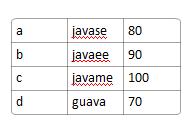Table是Guava提供的一个接口 Interface Table<R,C,V>,由rowKey+columnKey+value组成 它有两个键,一个值,和一个n行三列的数据表类似,n行取决于Table对对象中存储了多少个数据
主要使用的方法有:
- 所有行数据:cellSet()
- 所有第一个key值:rowKeySet()
- 所有课程:columnKeySet()
- 所有成绩:values()
- 课程成绩表:rowMap()+get(stu)/row(stu)
- 学生成绩表 columnMap()+get(course)/column(course)
给出一个学生-课程-成绩表,测试上面提到的方法,表如下 :

1.把数据存储到Table中,通过HashBasedTable.create()新建一个Table对象
Table<String,String,Integer> tables=HashBasedTable.create();
tables.put("a", "javase", 80);
tables.put("b", "javaee", 90);
tables.put("c", "javame", 100);
tables.put("d", "guava", 70);
2.得到所有行数据 tables.cellSet()
Set<Cell<String,String,Integer>> cells=tables.cellSet();
for(Cell<String,String,Integer> temp:cells){
System.out.println(temp.getRowKey()+" "+temp.getColumnKey()+" "+temp.getValue());
}
输出结果:
d guava 70
b javaee 90
c javame 100
a javase 80
3.得到所有学生 rowKeySet()
Set<String> students=tables.rowKeySet();
for(String str:students){
System.out.print(str+"\t");
}
输出结果:
d b c a
4.得到所有课程 columnKeySet()
Set<String> courses=tables.columnKeySet();
for(String str:courses){
System.out.print(str+"\t");
}
输出结果:
guava javaee javame javase
5.得到所有成绩:values
Collection<Integer> scores=tables.values();
for(Integer in:scores){
System.out.print(in+"\t");
}
输出结果:
70 90 100 80
6.得到学生的课程成绩表 rowMap+get(stu)/row(stu)
for(String str:students){
Map<String,Integer> rowMap=tables.row(str);
Set<Entry<String,Integer>> setEntry=rowMap.entrySet();
for(Entry<String,Integer> entry:setEntry){
System.out.println(entry.getKey()+" "+entry.getValue());
}
}
输出结果:
guava 70
javaee 90
javame 100
javase 80
7.得到学生的姓名成绩表 columnMap+get(course)/column(course)
for (String str : courses) {
Map<String, Integer> rowMap2 = tables.column(str);
Set<Entry<String, Integer>> setEntry2 = rowMap2.entrySet();
for (Entry<String, Integer> entry : setEntry2) {
System.out.println(entry.getKey() + " " + entry.getValue());
}
}
输出结果为:
d 70
b 90
c 100
a 80
Demo1
public class Demo08 {
public static void main(String[] args) {
//新建一个table对象,并存入数据
Table<String,String,Integer> tables=HashBasedTable.create();
tables.put("a", "javase", 80);
tables.put("b", "javaee", 90);
tables.put("c", "javame", 100);
tables.put("d", "guava", 70);
System.out.println("---------------------------按学生查看成绩---------------------------");
System.out.print("学生\t");
//得到所有课程
Set<String> courses=tables.columnKeySet();
for(String str:courses){
System.out.print(str+"\t");
}
System.out.println();
//得到所有学生
Set<String> stus=tables.rowKeySet();
for(String str:stus){
System.out.print(str+"\t");
//课程成绩表
Map<String,Integer> scores=tables.row(str);
for(String c:courses){
//输出成绩
System.out.print(scores.get(c)+"\t");
}
System.out.println();
}
System.out.println("---------------------------按课程查看成绩---------------------------");
System.out.print("课程\t");
//得到所有学生
Set<String> stus2=tables.rowKeySet();
for(String str:stus2){
System.out.print(str+"\t");
}
System.out.println();
//得到所有课程
Set<String> courses2=tables.columnKeySet();
for(String str:courses2){
System.out.print(str+"\t");
//得到学生成绩表
Map<String,Integer> map=tables.column(str);
for(String stu:stus2){
//输出成绩
System.out.print(map.get(stu)+"\t");
}
System.out.println();
}
System.out.println("---------------------------转换---------------------------");
//将列调换,由学生-课程-成绩表变为 课程-学生-成绩
Table<String,String,Integer> tables2=Tables.transpose(tables);
// 得到所有行数据
Set<Cell<String, String, Integer>> cells2 = tables2.cellSet();
for (Cell<String, String, Integer> temp : cells2) {
System.out.println(temp.getRowKey() + " " + temp.getColumnKey()+ " " + temp.getValue());
}
}
}
Demo2
package HashBasedTable;
import java.util.*;
import com.google.common.collect.HashBasedTable;
import com.google.common.collect.Lists;
import com.google.common.collect.Maps;
import com.google.common.collect.Table;
/**
* Created by Administrator on 2018/5/9.
*/
public class Demo01 {
public static void main(String[] args) {
Table<String, String, Integer> table = HashBasedTable.create();
table.put("0010", "i", 1);
table.put("0010", "e", 2);
table.put("0020", "c", 2);
Set<String> columnKeySet = table.columnKeySet();
Set<Table.Cell<String, String, Integer>> cellSet = table.cellSet();
Map<String, Integer> column = table.column("e");
Map<String, Integer> row = table.row("0010");
Map<String, Map<String, Integer>> rowMap = table.rowMap();
Set<String> rowKeySet = table.rowKeySet();//获取行的值到一个set集合中
List<Map<String, Integer>> list = new ArrayList();
int i = 0;
for (String r : rowKeySet) {
Map<String, Integer> map = new HashMap();
map = table.row(r);
list.add(i, map);
i++;
}
for (int j = 0; j < list.size(); j++) {
for (String m : list.get(j).keySet()) {
System.out.print(m + " " + list.get(j).get(m));
}
System.out.println();
}
}
}